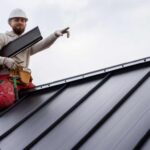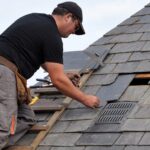In the expansive world of architectural design and modern residential construction, the term parapet roof has gained significant traction. But what is a parapet roof? At its core, a parapet roof comprises an extended wall at the edge of the roof. This architectural feature is not only functional but also aesthetically pleasing. Over the years, it has become a favored choice for homeowners looking to combine style with utility.
Whether you’re constructing a new home or planning to remodel your existing abode, understanding the nuances of a parapet roof can guide your decisions.

The Historical Background of Parapet Roofs
Parapet roofs date back to ancient times, primarily used for fortifications. Their vantage point allowed defenders to shield themselves while observing enemy movements. As architecture evolved, parapet roofs transitioned to more civilian uses, ornamenting buildings while providing practical benefits.
Notable Features of Parapet Roofs
A parapet roof is characterized by its wall extension. This extension can be purely decorative or serve to enhance safety on roof terraces.
Design Variations
Parapet roofs are versatile in design. From simple straight lines to intricate patterns, their design varies depending on architectural style and homeowner preference. Some parapet roofs also integrate decorative molding to enhance visual appeal.
Interested in learning about other roofing styles? Check out this guide for more information.
The Functionality of Parapet Roofs
Parapet roofs aren’t just about aesthetics. They serve several functional purposes, including:
Water Drainage
One of the primary functions of a parapet roof is to manage water runoff. It prevents uncontrolled water flow from the roof edge, channeling it efficiently into designated drainage systems.
Enhanced Safety
Especially essential for buildings with accessible roofs, parapet walls act as a protective barrier, minimizing the risk of falls.
Constructing a Parapet Roof
Planning the construction of a parapet roof? The process involves several steps:
Choosing the Right Materials
The choice of material is paramount. Commonly used materials include concrete, brick, and glass, each offering unique benefits.
Want to dive deeper into material choices? This article on roof materials and costs provides a comprehensive overview.
Integrating with Existing Structures
For renovations, integrating a parapet roof with the existing structure requires meticulous planning to ensure stability and aesthetic harmony.
Consulting with Professionals
Given the intricate nature of parapet roof construction, seeking expert guidance ensures seamless implementation. Looking for a roofing company? Here’s a helpful [resource](https://roof-home.com/how-to-choose-a-roof-construction-company/).
The Aesthetic Appeal of Parapet Roofs
Parapet roofs lend a distinct visual appeal to buildings. The elevation created by the parapet wall adds depth and dimension, making the structure stand out.
Blend of Tradition and Modernity
Parapet roofs seamlessly blend traditional architectural elements with modern designs, offering homeowners the best of both worlds.
Customization Options
Homeowners can personalize parapet roofs to match their aesthetic preferences, choosing from variations in height, decorative elements, and materials.
Curious about roof aesthetic styles? Explore top roofing materials for inspiration.
Cost Considerations
Building or renovating with parapet roofs involves costs that vary based on materials, design complexity, and regional construction rates.
Understanding Value for Money
While initial costs may be higher due to design complexities, the long-term benefits, including safety and aesthetics, offer tremendous value.
Challenges and Maintenance
Like any roofing system, parapet roofs require regular maintenance. Common challenges include:
Addressing Water Seepage
Although designed for efficient drainage, improper installation can lead to water seepage issues. Regular inspection can mitigate this risk.
Weathering Effects
Exposure to the elements can result in wear and tear over time. Routine maintenance ensures longevity and minimizes potential damage.
Engaging with Experts
Collaborating with professional roofers for periodic checks and maintenance can ensure your parapet roof remains in optimal condition.
Future Trends in Parapet Roof Design
The future of parapet roofs looks promising, with increasing emphasis on sustainable materials and eco-friendly designs.
Incorporating Green Spaces
Modern parapet roofs are being integrated with rooftop gardens, contributing to environmental sustainability and enhanced aesthetics.
Technological Integration
Emerging technology facilitates advanced drainage and insulation solutions, enhancing the functionality of parapet roofs.
Learn about innovative roofing technologies in this article.
Conclusion
Parapet roofs represent a delightful fusion of architectural beauty and practical functionality. Whether you’re looking to revamp your existing home or embarking on a new construction project, understanding what is a parapet roof and its myriad benefits can significantly impact your decision.

Frequently Asked Questions
Why choose a parapet roof for your home?
A parapet roof offers safety, aids in water drainage, and enhances a building’s aesthetic appeal.
What materials are best for parapet roofs?
Concrete and brick are popular choices due to their durability and visual appeal. However, the choice depends on the architectural style and individual preference.
How often should parapet roofs be maintained?
Regular checks, preferably annually, are recommended to ensure the roof’s integrity and longevity.
This article contains affiliate links. We may earn a commission at no extra cost to you.








